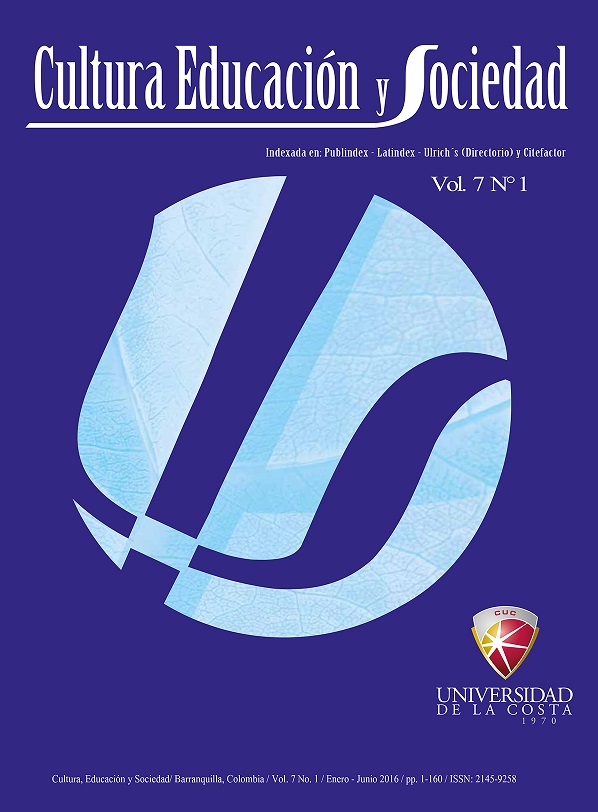Gypsy culture: Exclusive social process within inclussion
DOI:
https://doi.org/10.17981/cultedusoc.07.1.2016.1Keywords:
Romanian community; culture; inclusion; exclusion; social representationsAbstract
This work is aimed to present a contextualized re-flection on the social inclusion processes of the Roma-nian gypsy community which policies have become not only less effective but also exclusive in achiev-ing objectives of social inclusion, further these have developed segregating discourses, therefore, cul-tural identity of the mentioned community would be at risk of disappearing. It seems clear that further researches from psychologic views focused on social practicing related to strengthen the disregarded so-cial fabric should be carry out. Therefore the general objective of this research is aimed to infer about the essential features of the social representations and cultural values of the Romanian gipsy community by taking into account not only a grounded qualita-tive analysis of the hypotheses and discourses which are features in the field of psychologic but also their influences at the time of mediate an oppressed com-munity which has been affected by social exclusion. On other hand qualitative research methods were used in this work with the purpose of to examine the social facts of this community; with respect to the process of data collection twenty two research papers were used in order to outline significant facts from the gypsy community related to interpersonal relationships, family, scholar contexts, genders as well its role in social inclusion processes as exclusions. Finally, the obtained results have showed the function of the social inclusion process, which conversely is addressed to exclude cultures, so that this work, has estimated that this social phenomena has been repetitive due to the lack of significant mediations from the psychologic field.
Downloads
References
Abel, B. (2007). Proceso Organizativo del Pueblo Rom (Gitano) de Colombia (PRORROM), “Autodiagnóstico educativo de la kumpania Rom de Bogotá”. Recuperado de http://aprendeenlinea.udea.edu.co/revis-tas/index.php/revistaeyp/article/viewArticle/6655
Belaga, G. (2008). Sobre el Síntoma y el lazo social,Revista carta psicoana-lítica Nº 18. Recuperado de http://virtualia.eol.org.ar/018/template.asp?ampamerica/enapaol.html
Castel, R. (1995). De la exclusión como estado a la vulnerabilidad como proceso. Archipiélago, 21, 27-36. Recuperado de http://www.escuelas-sj.com/file.php/321/Exclusion_Robert_Castel_.pdf
Cole, M. (1999). Psicología cultural: una disciplina del pasado y del futuro. Ediciones Morata. Recuperado de https://books.google.es/books?hl=es&lr=&id=zV0a6blSEmsC&oi=fnd&pg =PA11&dq=Psicolog%C3%ADa+cultural:+una+disciplina+del+pasado+y+del+futuro.+&ots=07xPrsT-ie&sig=08VXoju60naaKchmaRF Zi28OPpo#v=onepage&q=Psicolog %C3 %ADa%20cultural%3A%20una%20disciplina%20del%20pasa-do%20y%20del%20futuro.&f=false
Del Olmo, M. (2005). Prejuicios y estereotipos: un replanteamiento de su uso y utilidad como mecanismos sociales. Enclave pedagógica, 7(2). Pag.14. Recuperado de http://www.uhu. es/publicaciones/ojs/index.php/xxi/article/viewArticle/672
Fernández, A. (2001). Sobre la identidad gitana. Gitanos, Pensamiento y Cultura, 11, 39-46. Recuperado de http://www.diocesisoa.org/documen-tos/ficheros/sobre_la_identidad_gitana_Tema_de_formacion_827.pdfI
Martí, T. Flecha, R. & Alexiu, T. (2013). El pueblo gitano: una identidad global sin territorio. Scripta Nova: revista electrónica de geografía y ciencias sociales, 1. Recuperado de http://dialnet.unirioja.es/servlet/articulo?codigo=4817089
Jiménez, M. (2008). Aproximación teórica de la exclusión social: complejidad e imprecisión del término. Consecuen-cias para el ámbito educativo. Estudios pedagógicos (Valdivia), 34(1), 173-186.Recuperado de http://www.scielo.cl/scielo.php?pid=S0718-07052008000100010&script=sci_arttext
Macías, F. & Redondo, G. (2012). Pueblo gitano, género y educación: investi-gar para excluir o investigar para transformar. International Jour-nal of Sociology of Education, 1(1), 71-92.Recuperado de http://hipa-tiapress.com/hpjournals/index.php/rise/article/view/140
Maraña, M. (2010). Cultura y Desarrollo: Evolución y Perspectivas. Cuadernos de Trabajo, 2010(1). Recuperado de http:/ /observatoriocultural.udg virtual.udg.mx/repositorio/handle/123456789/195
Martín, S. (2014). El Educador/a Social y la minoría gitana. Recuperado de https://uvadoc.uva.es/hand-le/10324/7345
Ministerio de Sanidad, Servicios Sociales e Igualdad. (2012). Estrategia Nacional para la inclusión social de la población gitana en España, 2012-2020. Madrid: Ministerio de Sanidad, Servicios Sociales e Igualdad. Recuperado de: http://www.msssi.gob.es/ssi/familiasInfancia/inclu-sionSocial/poblacionGitana/docs/Es-trategiaNacionalEs.pdf
Moreno, J. & Sánchez, M. (2000). Un estudio cualitativo de la minoría gitana. La vigencia de los componentes de la estructura social. Revista de Estudios Sociales y Sociología Aplicada” Documentación Social”, nº14 3 , 14 3,158. Recuperado de http://www.caritas.es/imagesrepository/Capitu-losPublicaciones/823/09%20UN%20ESTUDIO%20CUALITATIVO%20DE%20LA%20MINOR%C3%8DA%20GITANA.%20LA%20VIGEN-CIA%20DE%20LOS%20COMPONENTES%20DE%20LA%20ES-TRUCTURA%20SOCIAL.pdf
Pavón, D. (2011) La psicología crítica de Ian Parker: análisis de discurso, marxismo trotskista y psicoanálisis Lacaniano. Recuperado de http://teo-cripsi.com/documents/1pavon2.pdf
Rodríguez, M. & Espada, A. (2006). Discúlpeme... soy gitano (reflexiones de una trabajadora social paya). Accio-nes e investigaciones sociales, (1), 458. Recuperado de file:///C:/Users/HOGAR/Downloads/Dialnet-Dis-culpemeSoyGitanoReflexionesDeU-naTrabajadoraSoci-2002465%20(3).pdf
Rodríguez, L. (2012). Las barreras jurídico sociales en la satisfacción del derecho a la educación de los menores de etnia gitana. Recuperado de http://digibuo.uniovi.es/dspace/handle/10651/4056
Romero, M. (2006). Gitanos en san sal-vador de jujuy: exclusión desde el silencio. Recuperado de http://sm000153.ferozo.com/memorias/pdf/2006roromeromaria.pdf
Sampedro, H. (2011). La imagen del hom-bre en El malestar en la cultura de Sigmund Freud. Recuperado de http: //repository.javeriana.edu.co/hand-le/10554/6235
Sigmund, F. (1997). El malestar en la cultura.Bogotá: Editorial Skla.Soler, C. (2006). Lo que Lacan dijo de las mujeres. Estudio de psicoanálisis. Buenos Aires. Paidós, 2007.
Tenorio, M. & Sampson, A. (2000). Cultura e infancia. Recurso del grupo de Investigación Cultura y Desarrollo Humano, del Centro de Investigaciones y Estudios Avanzados en psicología, Cognición y Cultura de la Universidad del Valle. Recuperado dehttp://psicologiacultural.org/Pdfs/Sampson/Pdf%20Sampson%20capitulos/Cul-tura%20e%20infancia.pdf
Tuneu, N. (2009). La teoría de la inclusión: entre el desarrollo científico y la casualidad cotidiana. In El largo camino hacia una educación inclusiva: la educación especial y social del siglo XIX a nuestros días: XV Coloquio de Historia de la Educación, Pamplona-Iruñea, 29, 30 de junio y 1 de julio de 2009(pp. 171-180). Universidad Pública de Navarra. Recuperado de file:// /C:/Users/HOGAR/Downloads/Dialnet-LaTeoriaDeLaInclusion-2962540%20(1).pd
Downloads
Published
How to Cite
Issue
Section
License
Copyright (c) 2022 CULTURA EDUCACIÓN Y SOCIEDAD

This work is licensed under a Creative Commons Attribution-NonCommercial-NoDerivatives 4.0 International License.
![]()
Creative Commons 2020 CULTURA EDUCACIÓN Y SOCIEDAD
This article is under international license Creative Commons Reconocimiento-NoComercial-SinObrasDerivadas 4.0.
The published articles are the sole responsibility of their authors and do not necessarily reflect the opinions of the editorial committee.
CULTURA EDUCACIÓN Y SOCIEDAD respects the moral rights of its authors, who assign to the editorial committee the patrimonial rights of the published material. In turn, the authors inform that this work is unpublished and has not been previously published.
All articles are under a:
Licencia Creative Commons Atribución-NoComercial-SinDerivadas 4.0 Internacional.
![]()


 English
English
 Español (España)
Español (España)




_12.53_.27_p_. m_._3.png)





_12.57_.35_p_. m_._3.png)
_12.50_.37_p_. m_._3.png)



